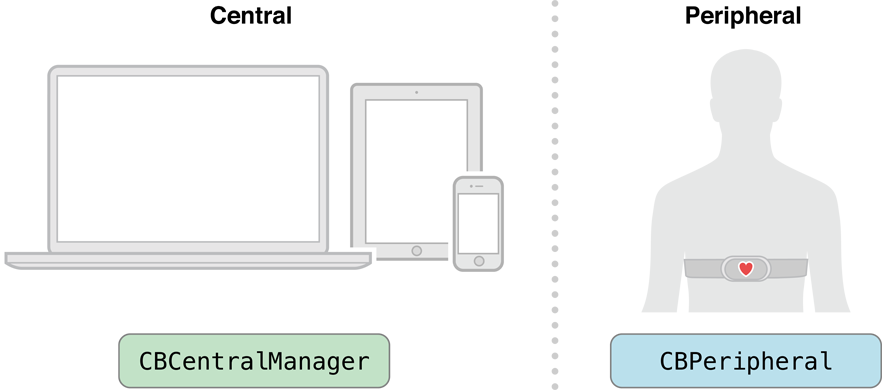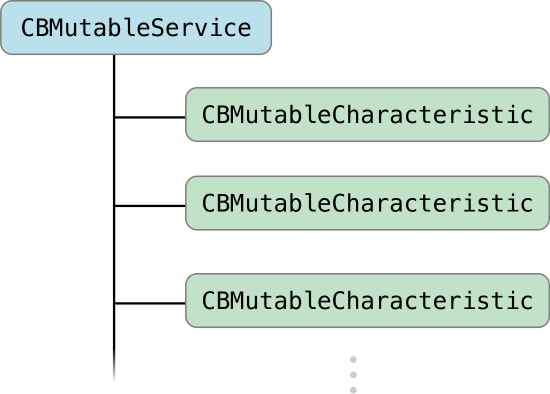蓝牙技术
2016-03-29 00:00
169 查看
蓝牙技术,很早以前就被有了,如今已更新4.0版本。很多热门技术都是基于它工作的,如Android平台的NFC,iOS的iBeancon等,现在的智能家居基本也是基于蓝牙4.0与APP进行通信。在iOS中,蓝牙是基于4.0标准的,设备间低功耗通信。
核心成员
在开始前我们回忆下传统的Socket编程,里面有Server服务端与Client端的区别。那么在蓝牙编程也是如此,其中Peripheral外设相当于Socket编程中的Server服务端,Central中心相当于Client客户端(ps吐槽下,Central中心,作为服务端,不更适合吗!)

你可以理解外设是一个广播数据的设备,它开始告诉外面的世界说它这儿有一些数据,并且能提供一些服务。另一边中心开始扫描周边有没有合适的设备,如果发现后,会和外设做连接请求,一旦连接确定后,两个设备就可以传输数据了。
在iOS6之后,iOS 设备可以是外设,也可以是中心,就像Socket编程中一样,你可以是服务端也可以是客户端,但与Socket不同的是不能在同时间扮演两个角色。
服务(service)和特征(characteristic)
每个蓝牙4.0的设备都是通过服务和特征来展示自己的,一个设备必然包含一个或多个服务,每个服务下面又包含若干个特征。特征是与外界交互的最小单位。比如说,智能音响设备,用服务A标识播放模块,特征A1来表示播放上一首,特征A2来表示播放下一首;服务B标识设置模块,特征B1设置彩灯颜色。这样做的目的主要为了模块化。
上面说了设备可以是外设,也可以是中心,也就是 本地中心->远程外设 、本地外设与远程中心,
不过在智能家居开发中,大部分硬件蓝牙都是担任外设的角色,也就是说我们应用只要扮演中心即可了。下面我们一一到来:
本地中心与远程外设
在中心这边,由CBCentralManager对象管理本地中心,来发现或连接远程外设。此时
正在连接的外设用CBPeripheral 对象表示。

远程外设的数据由CBService和CBCharacteristic对象表示
当你与远程外设CBPeripheral对象进行数据交互时,是由一个服务与特征操作的。

本地外设与远程中心
外设方面,由本地的外设CBPeripheralManager对象表示,同样,正在连接中的远程中心用CBCentral表示

当你设置好和本地Peripheral(表示为CBPeripheralManager)数据交互,就可以处理Service和Characteristic的可变版本。在Core Bluetooth框架中,本地Peripheral的Service表示为CBMutableService。同样地,本地Peripheral中Service的Characteristic表示为CBMutableCharacteristic。如下图所示:

使用
我们在这里只介绍本地中心与远程外设,如果你需要自己创建外设,请前往创建外设。
编程步骤:建立中心角色—扫描外设(discover)—连接外设(connect)—扫描外设中的服务和特征(discover)—与外设做数据交互(exploreand interact)—断开连接(disconnect)。
1、建立中心角色
_manager = [[CBCentralManageralloc]initWithDelegate:selfqueue:nil];
需要实现CBCentralManagerDelegate,queue为执行队列,默认为主线程
之后会回调,返回当前设备蓝牙状态
-(void)centralManagerDidUpdateState:(CBCentralManager *)central
{
switch (central.state){
case CBCentralManagerStatePoweredOn:
NSLog(@"蓝牙已打开,请扫描外设");
[selfscan];//扫描
break;
case CBCentralManagerStateUnsupported:
[AlertUtilsshowAlert:@"您的设备不支持蓝牙或蓝牙4.0"];
break;
case CBCentralManagerStateUnauthorized:
NSLog(@"未授权");
break;
caseCBCentralManagerStatePoweredOff://蓝牙未打开,系统会自动提示打开,所以不用自行提示
default:
break;
}
}
2、扫描外设(discover)
//扫描
-(void)scan{
NSLog(@"开始扫描。。");
[_managerscanForPeripheralsWithServices:niloptions:@{CBCentralManagerScanOptionAllowDuplicatesKey:@NO}];
//30秒以后停止
double delayInSeconds = 30.0;
dispatch_time_t popTime = dispatch_time(DISPATCH_TIME_NOW, (int64_t)(delayInSeconds*NSEC_PER_SEC));
dispatch_after(popTime, dispatch_get_main_queue(), ^(void){
[_managerstopScan];//停止扫描
NSLog(@"停止扫描。。");
});
}
使用scanForPeripheralsWithServices:options:进行扫描,第一个参数为Services的UUID(外设端的UUID),如果你只想发现周边特定的设备(自家的音响),那么就可以通过设备的UUID来限制。第二参数的CBCentralManagerScanOptionAllowDuplicatesKey为已发现的设备是否重复扫描,如果是同一设备会多次回调。
在开始扫描后,我们启动了一个延时队列,用于30秒后停止扫描,要知道扫描是件非常耗电的操作,因此你的应用不应该实时扫描周边设备。
发现外设,回调
//发现设备
-(void)centralManager:(CBCentralManager*)central didDiscoverPeripheral:(CBPeripheral*)peripheral advertisementData:(NSDictionary*)advertisementData RSSI:(NSNumber *)RSSI{
if (![_peripheralscontainsObject:peripheral]) {
[_peripheralsaddObject:peripheral];
NSLog(@"发现设备:%@",_peripherals);
[_tViewreloadData];
}
}
3、连接外设
//连接设备
-(BOOL)connect:(CBPeripheral*)peripheral{
NSLog(@"connectstart");
_currentPeripheral = nil;
[_managerconnectPeripheral:peripheraloptions:[NSDictionarydictionaryWithObject:[NSNumbernumberWithBool:YES]forKey:CBConnectPeripheralOptionNotifyOnDisconnectionKey]];
//开一个定时器监控连接超时的情况
connectTimer = [NSTimer scheduledTimerWithTimeInterval:5.0ftarget:selfselector:@selector(connectTimeout:) userInfo:peripheral repeats:NO];
return YES;
}
连接成功回调
//连接外设成功
- (void)centralManager:(CBCentralManager*)central didConnectPeripheral:(CBPeripheral*)peripheral
{
//[connectTimerinvalidate];//停止时钟
NSLog(@"Did connect toperipheral: %@", peripheral);
_currentPeripheral = peripheral;
[peripheral setDelegate:self];
[peripheraldiscoverServices:nil];//发现服务
}
//连接外设失败
-(void)centralManager:(CBCentralManager*)central didFailToConnectPeripheral:(CBPeripheral*)peripheral error:(NSError *)error
{
NSLog(@"%@",error);
}
4、发现服务与特征
//已发现服务
-(void) peripheral:(CBPeripheral*)peripheral didDiscoverServices:(NSError*)error{
for (CBService*s in peripheral.services){
[_serversaddObject:s];
}
for (CBService*s in peripheral.services){
NSLog(@"服务 UUID: %@(%@)",s.UUID.data,s.UUID);
[peripheral discoverCharacteristics:nil forService:s];
}
}
//已搜索到Characteristics
-(void) peripheral:(CBPeripheral*)peripheral didDiscoverCharacteristicsForService:(CBService*)service error:(NSError *)error{
NSLog(@"发现特征的服务:%@ (%@)",service.UUID.data ,service.UUID);
for (CBCharacteristic *c in service.characteristics) {
NSLog(@"特征UUID: %@ (%@)",c.UUID.data,c.UUID);
// if ([c.UUID isEqual:[CBUUIDUUIDWithString:@"2A06"]]) {//设置
// _writeCharacteristic = c;
// }
// if ([c.UUID isEqual:[CBUUIDUUIDWithString:@"2A19"]]) {//读取
// [_peripheral readValueForCharacteristic:c];
// }
//
// if ([c.UUID isEqual:[CBUUIDUUIDWithString:@"FFA1"]]) {
// [_peripheral readRSSI];
// }
// [_nCharacteristics addObject:c];
}
}
5、数据交互,分为两种,一种是直接读,另外一种订阅
6、断开连接
//主动断开设备
-(void)disConnect
{
if (_currentPeripheral != nil)
{
NSLog(@"disConnectstart");
[_managercancelPeripheralConnection:_currentPeripheral];
}
}
至此整个流程就跑完啦!
核心成员
在开始前我们回忆下传统的Socket编程,里面有Server服务端与Client端的区别。那么在蓝牙编程也是如此,其中Peripheral外设相当于Socket编程中的Server服务端,Central中心相当于Client客户端(ps吐槽下,Central中心,作为服务端,不更适合吗!)

你可以理解外设是一个广播数据的设备,它开始告诉外面的世界说它这儿有一些数据,并且能提供一些服务。另一边中心开始扫描周边有没有合适的设备,如果发现后,会和外设做连接请求,一旦连接确定后,两个设备就可以传输数据了。
在iOS6之后,iOS 设备可以是外设,也可以是中心,就像Socket编程中一样,你可以是服务端也可以是客户端,但与Socket不同的是不能在同时间扮演两个角色。
服务(service)和特征(characteristic)
每个蓝牙4.0的设备都是通过服务和特征来展示自己的,一个设备必然包含一个或多个服务,每个服务下面又包含若干个特征。特征是与外界交互的最小单位。比如说,智能音响设备,用服务A标识播放模块,特征A1来表示播放上一首,特征A2来表示播放下一首;服务B标识设置模块,特征B1设置彩灯颜色。这样做的目的主要为了模块化。
上面说了设备可以是外设,也可以是中心,也就是 本地中心->远程外设 、本地外设与远程中心,
不过在智能家居开发中,大部分硬件蓝牙都是担任外设的角色,也就是说我们应用只要扮演中心即可了。下面我们一一到来:
本地中心与远程外设
在中心这边,由CBCentralManager对象管理本地中心,来发现或连接远程外设。此时
正在连接的外设用CBPeripheral 对象表示。

远程外设的数据由CBService和CBCharacteristic对象表示
当你与远程外设CBPeripheral对象进行数据交互时,是由一个服务与特征操作的。

本地外设与远程中心
外设方面,由本地的外设CBPeripheralManager对象表示,同样,正在连接中的远程中心用CBCentral表示

当你设置好和本地Peripheral(表示为CBPeripheralManager)数据交互,就可以处理Service和Characteristic的可变版本。在Core Bluetooth框架中,本地Peripheral的Service表示为CBMutableService。同样地,本地Peripheral中Service的Characteristic表示为CBMutableCharacteristic。如下图所示:

使用
我们在这里只介绍本地中心与远程外设,如果你需要自己创建外设,请前往创建外设。
编程步骤:建立中心角色—扫描外设(discover)—连接外设(connect)—扫描外设中的服务和特征(discover)—与外设做数据交互(exploreand interact)—断开连接(disconnect)。
1、建立中心角色
_manager = [[CBCentralManageralloc]initWithDelegate:selfqueue:nil];
需要实现CBCentralManagerDelegate,queue为执行队列,默认为主线程
之后会回调,返回当前设备蓝牙状态
-(void)centralManagerDidUpdateState:(CBCentralManager *)central
{
switch (central.state){
case CBCentralManagerStatePoweredOn:
NSLog(@"蓝牙已打开,请扫描外设");
[selfscan];//扫描
break;
case CBCentralManagerStateUnsupported:
[AlertUtilsshowAlert:@"您的设备不支持蓝牙或蓝牙4.0"];
break;
case CBCentralManagerStateUnauthorized:
NSLog(@"未授权");
break;
caseCBCentralManagerStatePoweredOff://蓝牙未打开,系统会自动提示打开,所以不用自行提示
default:
break;
}
}
2、扫描外设(discover)
//扫描
-(void)scan{
NSLog(@"开始扫描。。");
[_managerscanForPeripheralsWithServices:niloptions:@{CBCentralManagerScanOptionAllowDuplicatesKey:@NO}];
//30秒以后停止
double delayInSeconds = 30.0;
dispatch_time_t popTime = dispatch_time(DISPATCH_TIME_NOW, (int64_t)(delayInSeconds*NSEC_PER_SEC));
dispatch_after(popTime, dispatch_get_main_queue(), ^(void){
[_managerstopScan];//停止扫描
NSLog(@"停止扫描。。");
});
}
使用scanForPeripheralsWithServices:options:进行扫描,第一个参数为Services的UUID(外设端的UUID),如果你只想发现周边特定的设备(自家的音响),那么就可以通过设备的UUID来限制。第二参数的CBCentralManagerScanOptionAllowDuplicatesKey为已发现的设备是否重复扫描,如果是同一设备会多次回调。
在开始扫描后,我们启动了一个延时队列,用于30秒后停止扫描,要知道扫描是件非常耗电的操作,因此你的应用不应该实时扫描周边设备。
发现外设,回调
//发现设备
-(void)centralManager:(CBCentralManager*)central didDiscoverPeripheral:(CBPeripheral*)peripheral advertisementData:(NSDictionary*)advertisementData RSSI:(NSNumber *)RSSI{
if (![_peripheralscontainsObject:peripheral]) {
[_peripheralsaddObject:peripheral];
NSLog(@"发现设备:%@",_peripherals);
[_tViewreloadData];
}
}
3、连接外设
//连接设备
-(BOOL)connect:(CBPeripheral*)peripheral{
NSLog(@"connectstart");
_currentPeripheral = nil;
[_managerconnectPeripheral:peripheraloptions:[NSDictionarydictionaryWithObject:[NSNumbernumberWithBool:YES]forKey:CBConnectPeripheralOptionNotifyOnDisconnectionKey]];
//开一个定时器监控连接超时的情况
connectTimer = [NSTimer scheduledTimerWithTimeInterval:5.0ftarget:selfselector:@selector(connectTimeout:) userInfo:peripheral repeats:NO];
return YES;
}
连接成功回调
//连接外设成功
- (void)centralManager:(CBCentralManager*)central didConnectPeripheral:(CBPeripheral*)peripheral
{
//[connectTimerinvalidate];//停止时钟
NSLog(@"Did connect toperipheral: %@", peripheral);
_currentPeripheral = peripheral;
[peripheral setDelegate:self];
[peripheraldiscoverServices:nil];//发现服务
}
//连接外设失败
-(void)centralManager:(CBCentralManager*)central didFailToConnectPeripheral:(CBPeripheral*)peripheral error:(NSError *)error
{
NSLog(@"%@",error);
}
4、发现服务与特征
//已发现服务
-(void) peripheral:(CBPeripheral*)peripheral didDiscoverServices:(NSError*)error{
for (CBService*s in peripheral.services){
[_serversaddObject:s];
}
for (CBService*s in peripheral.services){
NSLog(@"服务 UUID: %@(%@)",s.UUID.data,s.UUID);
[peripheral discoverCharacteristics:nil forService:s];
}
}
//已搜索到Characteristics
-(void) peripheral:(CBPeripheral*)peripheral didDiscoverCharacteristicsForService:(CBService*)service error:(NSError *)error{
NSLog(@"发现特征的服务:%@ (%@)",service.UUID.data ,service.UUID);
for (CBCharacteristic *c in service.characteristics) {
NSLog(@"特征UUID: %@ (%@)",c.UUID.data,c.UUID);
// if ([c.UUID isEqual:[CBUUIDUUIDWithString:@"2A06"]]) {//设置
// _writeCharacteristic = c;
// }
// if ([c.UUID isEqual:[CBUUIDUUIDWithString:@"2A19"]]) {//读取
// [_peripheral readValueForCharacteristic:c];
// }
//
// if ([c.UUID isEqual:[CBUUIDUUIDWithString:@"FFA1"]]) {
// [_peripheral readRSSI];
// }
// [_nCharacteristics addObject:c];
}
}
5、数据交互,分为两种,一种是直接读,另外一种订阅
6、断开连接
//主动断开设备
-(void)disConnect
{
if (_currentPeripheral != nil)
{
NSLog(@"disConnectstart");
[_managercancelPeripheralConnection:_currentPeripheral];
}
}
至此整个流程就跑完啦!
相关文章推荐
- 蓝牙蓝牙
- Golang实现A星路径搜索算法
- MFC基础之制作表格
- 动态规划——最长公共子序列
- Android学习-简易ViewPager的使用教程与Demo演示
- 检测哪里用到IDFA
- QT5的信号和槽.
- UITextField只要求输入数字和字母,并限制长度
- 被大家忽略的UITableViewHeaderFooterView,cell的展开和折叠
- 助你展翅翱翔,金鹰飞翔计划开始啦!
- 传统店家做电商不能只靠淘宝
- 安装dubbo管理控制台
- jsp页面的两种编码设置格式区别
- jsp错误页的设置
- EF分页查询
- Tomcat和JBoss都是服务器,有什么区别呢
- 字符串双向加密
- jq 选择器简单使用
- 验证所有类型的信用卡类
- 知道什么网站并发量吗?如何测试呢?这个必须了解了解。。。。
